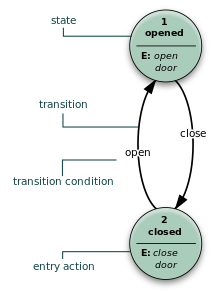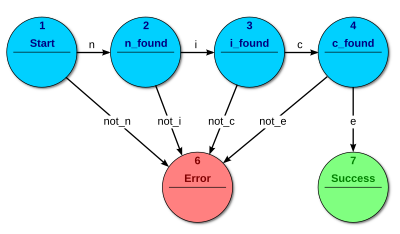Many features found in modern regular expression libraries provide an expressive power that far exceeds the regular languages. For example, many implementations allow grouping subexpressions with parentheses and recalling the value they match in the same expression (backreferences). This means that a pattern can match strings of repeated words like "papa" or "WikiWiki", called squares in formal language theory. The pattern for these strings is
(.*)\1.The language of squares is not regular, nor is it context-free. Pattern matching with an unbounded number of back references, as supported by numerous modern tools, is NP-complete (see,[11] Theorem 6.2).
However, many tools, libraries, and engines that provide such constructions still use the term regular expression for their patterns. This has led to a nomenclature where the term regular expression has different meanings in formal language theory and pattern matching. For this reason, some people have taken to using the term regex or simply pattern to describe the latter. Larry Wall, author of the Perl programming language, writes in an essay about the design of Perl 6:
There are at least three different algorithms that decide if and how a given regular expression matches a string.
The oldest and fastest two rely on a result in formal language theory that allows every nondeterministic finite automaton (NFA) to be transformed into a deterministic finite automaton (DFA). The DFA can be constructed explicitly and then run on the resulting input string one symbol at a time. Constructing the DFA for a regular expression of size m has the time and memory cost of O(2m), but it can be run on a string of size n in time O(n). An alternative approach is to simulate the NFA directly, essentially building each DFA state on demand and then discarding it at the next step, possibly with caching. This keeps the DFA implicit and avoids the exponential construction cost, but running cost rises to O(nm). The explicit approach is called the DFA algorithm and the implicit approach the NFA algorithm. As both can be seen as different ways of executing the same DFA, they are also often called the DFA algorithm without making a distinction. These algorithms are fast, but using them for recalling grouped subexpressions, lazy quantification, and similar features is tricky.[12][13]
The third algorithm is to match the pattern against the input string by backtracking. This algorithm is commonly called NFA, but this terminology can be confusing. Its running time can be exponential, which simple implementations exhibit when matching against expressions like
(a|aa)*b that contain both alternation and unbounded quantification and force the algorithm to consider an exponentially increasing number of sub-cases. This behavior can cause a security problem called Regular expression Denial of Service - ReDoS, which might be used by hackers who want to attack a regular expression engine. More complex implementations will often identify and speed up or abort common cases where they would otherwise run slowly.Although backtracking implementations only give an exponential guarantee in the worst case, they provide much greater flexibility and expressive power. For example, any implementation which allows the use of backreferences, or implements the various extensions introduced by Perl, must use a backtracking implementation.
Some implementations try to provide the best of both algorithms by first running a fast DFA match to see if the string matches the regular expression at all, and only in that case perform a potentially slower backtracking match.
In theoretical terms, any token set can be matched by regular expressions as long as it is pre-defined. In terms of historical implementations, regular expressions were originally written to use ASCII characters as their token set though regular expression libraries have supported numerous other character sets. Many modern regular expression engines offer at least some support for Unicode. In most respects it makes no difference what the character set is, but some issues do arise when extending regular expressions to support Unicode.
- Supported encoding. Some regular expression libraries expect to work on some particular encoding instead of on abstract Unicode characters. Many of these require the UTF-8 encoding, while others might expect UTF-16, or UTF-32. In contrast, Perl and Java are agnostic on encodings, instead operating on decoded characters internally.
- Supported Unicode range. Many regular expression engines support only the Basic Multilingual Plane, that is, the characters which can be encoded with only 16 bits. Currently, only a few regular expression engines (e.g., Perl's and Java's) can handle the full 21-bit Unicode range.
- Extending ASCII-oriented constructs to Unicode. For example, in ASCII-based implementations, character ranges of the form
[x-y]are valid wherever x and y are codepoints in the range [0x00,0x7F] and codepoint(x) ≤ codepoint(y). The natural extension of such character ranges to Unicode would simply change the requirement that the endpoints lie in [0x00,0x7F] to the requirement that they lie in [0,0x10FFFF]. However, in practice this is often not the case. Some implementations, such as that of gawk, do not allow character ranges to cross Unicode blocks. A range like [0x61,0x7F] is valid since both endpoints fall within the Basic Latin block, as is [0x0530,0x0560] since both endpoints fall within the Armenian block, but a range like [0x0061,0x0532] is invalid since it includes multiple Unicode blocks. Other engines, such as that of the Vim editor, allow block-crossing but limit the number of characters in a range to 128. - Case insensitivity. Some case-insensitivity flags affect only the ASCII characters. Other flags affect all characters. Some engines have two different flags, one for ASCII, the other for Unicode. Exactly which characters belong to the POSIX classes also varies.
- Cousins of case insensitivity. As ASCII has case distinction, case insensitivity became a logical feature in text searching. Unicode introduced alphabetic scripts without case like Devanagari. For these, case sensitivity is not applicable. For scripts like Chinese, another distinction seems logical: between traditional and simplified. In Arabic scripts, insensitivity to initial, medial, final, and isolated position may be desired. In Japanese, insensitivity between hiragana and katakana is sometimes useful.
- Normalization. Unicode introduced combining characters. Like old typewriters, plain letters can be followed by one of more non-spacing symbols (usually diacritics like accent marks) to form a single printing character. Consider a letter with both a grave and an acute accent mark. That might be written with the grave appearing before the acute, or vice versa. As a consequence, two different code sequences can result in identical character display.
- New control codes. Unicode introduced amongst others, byte order marks and text direction markers. These codes might have to be dealt with in a special way.
- Introduction of character classes for Unicode blocks, scripts, and numerous other character properties. Block properties are much less useful than script properties, because a block can have code points from several different scripts, and a script can have code points from several different blocks.[14] In Perl and the
java.util.regexlibrary, properties of the form\p{InX}or\p{Block=X}match characters in block X and\P{InX}or\P{Block=X}matches code points not in that block. Similarly,\p{Armenian},\p{IsArmenian}, or\p{Script=Armenian}matches any character in the Armenian script. In general,\p{X}matches any character with either the binary propery X or the general category X. For example,\p{Lu},\p{Uppercase_Letter}, or\p{GC=Lu}matches any upper-case letter. Binary properties that are not general categories include\p{White_Space},\p{Alphabetic},\p{Math}, and\p{Dash}. Examples of non-binary properties are\p{Bidi_Class=Right_to_Left},\p{Word_Break=A_Letter}, and\p{Numeric_Value=10}.
Regular expressions are useful in the production of syntax highlighting systems, data validation, and many other tasks.
While regular expressions would be useful on search engines such as Google, processing them across the entire database could consume excessive computer resources depending on the complexity and design of the regex. Although in many cases system administrators can run regex-based queries internally, most search engines do not offer regex support to the public







 or its equivalent
or its equivalent  . Then, since
. Then, since  implies a contradiction, conclude
implies a contradiction, conclude  or
or  ), struck-out arrows (
), struck-out arrows ( ), a stylized form of hash (such as U+2A33: ⨳), or the "reference mark" (U+203B: ※).
), a stylized form of hash (such as U+2A33: ⨳), or the "reference mark" (U+203B: ※). this is equivalent to assuming that
this is equivalent to assuming that  That is, to assume that
That is, to assume that 





